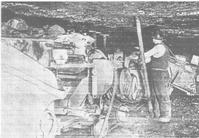


Chapter 11
I The Present Energy Economy
II Australian Energy Consumption
III Research And Development
IV Coal
i Transition at the coal face
ii Further development of face mechanisation
iii Mechanisation outside the face area
iv Open-cut mining in NSW
v Open-cut mining in Queensland
vi Underground mining in Queensland
vii The state of the art
viii Conclusion
V Oil And Natural Gas
VI Solar Energy
VII Nuclear Energy
VIII Bagasse Firewood And Other Biomass
IX Electric Power Generation And Distribution electric Power Generation And Distribution
X Manufactured Gas
XI Industrial Process Heat
Sources
Index
Search
Help
Contact us

The strata control problems associated with bord and pillar mining are multiplied under longwall conditions, as the abutment pressures generated are time dependent in magnitude and do not cease advancing when the coal face is stationary. Extended face stoppages for whatever cause can result in serious and costly disruption to the working area. For that reason the ideal situation is one in which, once commenced, extraction is continuous until the complete block of coal is extracted.

The promise held out by longwall mining led to an application to the Coal Industry Tribunal for the right of 24 hour production and in 1970-71 this was granted on a five day basis in exchange for an award working week of 35 hours. The measure increased overall production figures and greatly enhanced the utilisation of capital equipment. It is virtually a necessity for an underground mine to have an operating longwall to be viable in the present economic climate.
Organisations in Australian Science at Work - Coal Industry Tribunal
 |
Australian Academy of Technological Sciences and Engineering |  |
© 1988 Print Edition page 791, Online Edition 2000
Published by Australian Science and Technology Heritage Centre, using the Web Academic Resource Publisher
http://www.austehc.unimelb.edu.au/tia/761.html